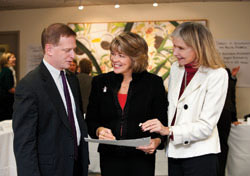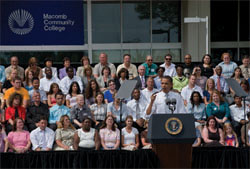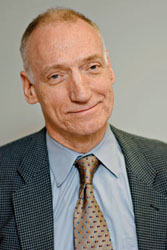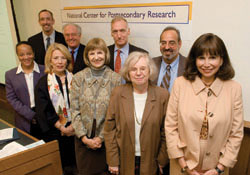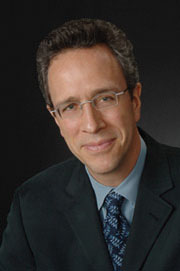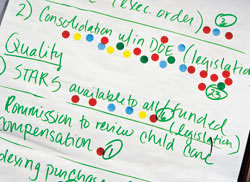Shaping Education for Young and Old
The ideas of TC faculty members Sharon Lynn Kagan and Tom Bailey are central in legislation currently before Congress
In Fall 2009, Congress considered proposals that would allocate billions of dollars to community colleges and early childhood education—the clearest sign yet that the national discussion has finally caught up with Teachers College faculty members Sharon Lynn Kagan and Thomas Bailey. Both are leading policy experts in their fields, Kagan in early childhood education and Bailey in community colleges.
When Kagan and Bailey began their work decades ago at the state and local levels, the big goal was simply to win greater access to education for low-income children and adults. Over the years, however, the two have helped move the discussion to a new level. Thanks to their efforts—and, as they are quick to acknowledge, those of many others—the focus today is on creating cohesive systems that include meaningful funding, coordinated effort and standards for the quality of preschools and community colleges, rather than just the quantity of programs or the number of seats available.
Kagan is co-director of TC’s National Center for Children and Families with Jeanne Brooks-Gunn, and Bailey is the founding director of TC’s Community College Research Center. Both do research that examines what types of schools and teaching methods are best. That research provides ammunition for those advocating for high-quality preschools and community colleges as important pieces of the national solution to educational and economic problems. And while neither was directly involved in writing or lobbying for the proposals that went before Congress, each was consulted regarding their content. More important, both were among the first to study, write about and advocate at the state, national and international levels for their respective subfields in education.
“When we talk about policy people who are wired in to the real world, Lynn Kagan and Tom Bailey are as good as they come, anywhere,” says TC President Susan Fuhrman.
Lynn Kagan and Early Childhood Education
“Let’s get together so we can finish up our work!”
Lynn Kagan might have been calling children in from recess at the Head Start program where she worked early in her career. Instead, at a meeting one day last December in Delaware, she was waving over the state’s lieutenant governor and its cabinet officials for education, families, health and social services, all of whom were there to plan a statewide, coordinated approach to early childhood education.
Certainly Kagan, TC’s Virginia and Leonard Marx Professor of Early Childhood and Family Policy, has both the personality and the resume to command the attention of such a gathering. No one has done more during the past three decades to champion the idea that the first five years of life are a critically important window for learning essential skills, habits and information.
Professorial in her manner but with the firmness of a ward politician from her native Detroit, Kagan has advised legislators, governors, Presidents and other nations on early childhood learning. Her fingerprints are on virtually every major report or panel on the subject that has emerged over the past decade.
At the same time, Kagan has been way ahead of the field in seeing the potential to bring different players together. Throughout her career, she has built a powerful case for creating an early childhood education and care system that uses multiple federal, state and local funding streams as efficiently as possible and is aligned with kindergarten and elementary school programs.
Those ideas are distilled in a well-worn slide of Kagan’s that depicts eight interlocking components: early childhood programs; improving quality and regulation; personnel and professional development; financing; informed families and informed public; standards; assessment and accountability; linkages to K–12 education; and governance. At the bottom of the slide are the words: “Eight minus one equals zero,” because as Kagan explains, “If you take away any one of these elements, you end up with nothing.”
Kagan has not only preached this model, she has helped put it into practice. Over the years, she has worked with the majority of states and more than 40 of the world’s poorest countries to help develop coherent early childhood education policies and practices. This is easiest, she says, in countries that have little or no national education system, because there are no preexisting structures working at cross-purposes. The United States, with its largely uncoordinated thicket of state and local education systems that vary greatly in quality, is bigger and messier. As Kagan herself has described in numerous writings, states spend vastly different amounts on early childhood education. (Washington State, for example, spends more than $9,000 per child on Head Start programs, while Washington, D.C. spends a little over $700.) States also hold teachers to different standards and provide children with varying levels of access to early childhood education.
That picture must change dramatically, Kagan believes. Just as states and, to some degree, the federal government, have systems and standards for educating children from kindergarten through college, early childhood education needs the same predictable funding and standards for teaching, teacher training, learning and care of children from birth to age five. Without them, the United States will continue to decline relative to other countries on measures of educational success and economic prosperity.
“Early childhood is so behind,” Kagan says. “We’ve got dedicated funding streams for K–12 education through property taxes; these are durable. In early childhood, we have to fight, program by program, year by year, for funding. In K–12 education, we have mandated and funded local and state school boards to lend coherence to education; in early childhood, we have no governance apparatus.”
Now there’s real hope for improvement, and the ideas that Kagan and others have promoted are at the center of it. The proposals that went before Congress would fund increases in the number of high-quality early learning programs and the number of disadvantaged children who participate in them. They would also require states to submit proposals, supported by statistics, on how they would implement a program rating system that builds on licensing requirements and other state regulatory standards and includes mechanisms for evaluating how programs are meeting those standards.
Roberto J. Rodriguez, who serves on the White House Domestic Policy Council as special assistant to President Obama for education, says Kagan’s work on raising the quality of early learning environments and improving outcomes for young children in early childhood programs “has been particularly instrumental in the development of policy” at the White House. “Lynn is very adept at marrying the policy with the practices with the research,” says Rodriguez, who spoke at the annual Federal Policy Institute that Kagan organizes for TC students. “You don’t very often find academics as accomplished as Lynn who are able to distill their research and their findings in a way that is as easily accessible to policymakers.”
How did a Head Start teacher evolve into a unique hybrid of academic, policy wonk and politician—and more importantly, become such an influential thinker in such a hot field?
“By design, I’ve had my feet in the trenches and in the Ivy League halls,” she explains. “I chose to work in the different kinds of early childhood venues because I wanted to understand the field fully.”
After graduating from the University of Michigan, Kagan taught Head Start in Baltimore County, Maryland, and New Haven and North Haven, Connecticut, because she wanted to work with poor children and their families. She served as a Head Start director and elementary school principal, a state education specialist and as a fellow in the U.S. Senate, where she assiduously worked both sides of the aisle. Connecticut Democrat Christopher Dodd “was my Senator,” she says, “so I went to intern for him, but I also fashioned opportunities to intern for [Republican Senator] Orrin Hatch, because I had to understand how the Republicans are thinking about this stuff.”
After earning a doctorate in Curriculum and Teaching from Teachers College, Kagan worked in the 1990s at the Yale Child Study Center and at Yale’s Bush Center in Child Development and Social Policy. While at Yale, Kagan served as Co-Chair of President George W. Bush’s National Education Goals Panel on Goal One (readiness to learn), which led to the Good Start, Growth Start national initiative that served as the basis for mandatory state standards on early childhood education.
It was during two years away from Yale, when she was serving as executive director of New York City’s Office of Early Childhood Education under Mayor Edward I. Koch, that Kagan had an early “Aha” moment about the need to create a true early childhood education system. In the mayor’s office, she directed a program called Giant Step, which worked to integrate three major programs, departments and funding streams for early childhood services—federal Head Start and childcare programs and the local Board of Education. “Up until that time there had been little coordination, indeed, probably little communication among those programs,” Kagan recalls. “I thought, ‘This is pretty stupid. We’ve got all these different programs. We’re spending extra money. Let’s take some of the money that could be achieved via some sort of consolidation and perhaps focus it more on quality or more on direct services.’ ”
Not long afterward, Kagan was chosen to lead the Quality 2000 Initiative, through which the Carnegie Corporation of New York convened an international task force of 350 to create an early childhood care and education system for the nation. In 1997, the guiding team of that effort published “Not By Chance,” a report that includes Kagan’s eight interlocking components and “probably was the first delineation of the elements of a system,” she says. “If you look at that and then you look at what’s been considered in Congress, you will see striking similarities.” The report also established the need for an infrastructure that would support all types of early childhood programs, from preschools to child care to health care to teacher education.
“Quality 2000, which was a collaboration of many leaders in the education field, and which Lynn and I and others created, led to a blueprint which basically forms the basis for many of the changes that we have seen,” says Michael Levine, who is the Deputy Chair and Senior Program Officer at the Carnegie Foundation and the founding executive director of the Joan Ganz Cooney Center for Children’s Media and Research at Sesame Workshop. “A lot of the different structures that Lynn suggested there are becoming codified in national policy and have been instrumental in shaping state policy.”
More recently, Kagan also served on the New Commission on the Skills of the American Workforce for the National Center on Education and the Economy. The commission’s report, “Tough Choices or Tough Times,” recommended “high-quality early childhood education [as] one of the best investments a nation can make in its young people.” It traced the nation’s economic survival not just back through its K–12 education system but to preschool, and called for the creation of “high performance schools and districts everywhere—[and] how the system should be governed, structured, financed, organized and managed.”
More specifically, the report recommended shifting some $60 billion in K–12 education spending into pre-K. That recommendation was proposed and championed by Lynn Kagan, though “all the named members of the committee were certainly highly supportive and didn’t need much convincing,” she recalls.
It is clear that, by consistently working on the policy front using data that she and her students have created, Kagan will continue to play a significant role in shaping the conversation toward a national early childhood system. She’ll do that partly by continuing to make an impact at the state level. But perhaps just as importantly, she’ll also continue to send her students out into the world in an ever-widening sphere of influence.
At her meeting with state officials in Delaware in December, Kagan watched carefully as Kate Tarrant and Rebecca Gomez, two of her students, guided the participants through exercises designed to stimulate thinking about the issues surrounding early childhood education and consensus-building around state priorities.
“I believe Teachers College has an obligation to train students not only in the theory but the practice of early childhood education,” she said. “My goal is to make sure my students are switch hitters. I want them to be able to go into any job—a policy job, academic job, a think tank—and produce and disseminate research.”
Thomas Bailey and the Community College research agenda
In July 2009, speaking at Macomb Community College in Warren, Michigan, President Obama announced a $12-billion federal plan to modernize and expand the nation’s community colleges and prepare millions of workers for post-Rust Belt jobs. In the fall, Congress considered proposals to provide federal funds to improve physical plants and programming at community colleges, tie these institutions more closely to emerging economic needs and to study methods to improve their graduation rates.
According community colleges a major role in America’s economic recovery might seem obvious. After all, there are 1,200 of them nationally, and they enroll more than six million degree-seeking students in any given year. Perhaps even more important, with so-called “minority” populations in the United States on course to outnumber whites by 2050, they constitute the major gateway to higher education for low-income students and students of color. (Fact: there are more Hispanic and black students enrolled in the two community colleges in the Bronx than in the entire Ivy League.)
“If you’re going to increase the population that has some college, it isn’t going to be among upper middle-class white people,” says Thomas Bailey, TC’s George & Abby O’Neill Professor of Economics and Education. “Community colleges will have to play a central role.”
Not surprisingly, much of Bailey’s own thinking is embodied in the proposals that went before Congress. Backed by a stream of major grants from the federal government and leading foundations such as Sloan, Gates, Lumina and Irvine, and through landmark books such as Defending the Community College Equity Agenda (co-edited with Vanessa Smith Morest), Bailey has been a leading voice over the past 20 years in focusing attention on the potential of community colleges to serve as an engine of upward mobility for the students they serve and of economic growth for the country. But it may be the self-study component of what Congress considered this past fall that best reflects his contributions.
“When the CCRC was started by Tom over 10 years ago, community colleges were basically in the backwoods of any kind of research,” says Macomb Community College President James Jacobs, who has worked closely with Bailey for years, including serving as associate director of CCRC and chair of its Advisory Board. “Those of us inside community colleges were often faced with huge anecdotal evidence, but never systematically looked at what we were doing. Over the years through his creativity and his persistence, he has really built a research agenda that is increasingly the agenda for all of us in community colleges. Without a doubt, the people who helped shape the Obama higher education policy, which is still evolving, are very influenced by the work of CCRC and Tom Bailey.”
Bailey, a Harvard- and MIT-educated economist, and his colleagues at CCRC, were among the first to ask the tough questions of a system that historically has received more credit (and funding) for getting students in the door than for carrying them through to graduation. Specifically, why do more than 60 percent of community college students need remedial coursework (the more popular adjective now is “developmental”) in math, reading or writing, before they can enroll in college-level courses—and why do these courses so often fail to engage them? Why do so many students drop out before graduating? (Bailey himself has found that less than one-quarter of community college students who enrolled in developmental education complete a degree or certificate within eight years of enrollment in college.) And why are community colleges in some areas failing to meet regional employment demands?
For decades, community colleges were expected to provide access to college, and little attention was paid to what happened to those students. But with the nation in the throes of a recession, these questions are being asked with new urgency by policymakers worried about budgets and the need to produce graduates who can fill high-skills jobs.
Closer structurally to the locally controlled K–12 education system than to higher education, community colleges were popularized by President Truman following World War II to help educate and train millions of returning veterans for postwar jobs. Since the 1960s they have typically educated first-generation college students and the children of immigrants and minority families—the largely low-income, disadvantaged demographic which Bailey, who came of age in the early 1970s, likes to champion. Possibly for that reason, two-year public institutions have traditionally been a poor stepsister of their more prestigious four-year counterparts, never receiving the resources that their enrollments and economic importance would seem to justify.
Still, with the promise they hold to help low-income people help themselves, community colleges have evolved steadily from higher education’s Rodney Dangerfield to a favorite of leaders on both sides of the aisle. In 1988, Vice President George H. W. Bush made a presidential campaign stop at Macomb Community College to discuss his plans for higher education. Both he and the second President Bush viewed and funded community colleges as economic and job development tools. For his part, President Bill Clinton proposed a tuition tax credit for community college students.
Bailey founded CCRC in 1996 with funding from the Alfred P. Sloan Foundation. Since then he and his fellow researchers have studied nearly every aspect of community colleges, including how and what they teach, how successful they are and how they fit into the nation’s higher education system and workforce economy.
In 2006, the Center—in collaboration with the research organization MDRC and the Curry School of Education at the University of Virginia—received $10 million from the Institute of Education Sciences at the U.S. Department of Education to establish the National Center for Postsecondary Research (NCPR), which focuses on measuring the effectiveness of programs designed to help students make the transition to college and master basic skills needed to advance to a degree. To date, NCPR has focused much of its research on developmental summer bridge programs, which help academically struggling students just before they start college; developmental learning communities, in which groups of college students enroll together in linked courses; and dual enrollment programs.
In particular, CCRC has emerged as a national authority on dual enrollment programs, in which high school students take college classes in order to improve their chances of completing a two- or four-year degree. In 2007, the Center secured $4.4 million from the The James Irvine Foundation to funnel money to dual-enrollment partnerships between high schools and community colleges in California.
Bailey’s and CCRC’s projects with individual states have served as national models. The Center’s research was used extensively to support the creation of the state of Washington’s Integrated Basic Education and Skills Training (I-BEST) program, offered at all 34 of the state’s community and technical colleges, which combines basic education and support services with job skills training to prepare low-skilled adults for high-demand jobs. After preliminary research suggested that I-BEST increased the participant’s chances of earning a college-level occupational credential, the program received extensive national coverage and is being replicated in other states.
In 2009, CCRC completed a study for the Virginia Community College System that documented the low success rates of remedial programs. The project is connected to “Achieving the Dream: Community Colleges Count,” a multiyear, national initiative launched in 2003 by the Lumina Foundation for Education to help community colleges succeed with low-income students and students of color. It found that a majority of the 24,000 students who entered the system in 2004 failed to complete first-level English or math courses, in many cases because they never made it out of remedial classes. Many students who were recommended for developmental education but skipped it did as well as those who took developmental courses, suggesting that developmental instruction does not make a difference.
“This is something that Tom has gently pointed out for a long time,” says CCRC researcher Davis Jenkins, who conducted the study with Shanna Smith Jaggars and Josipa Roksa. “While community colleges have provided access, their record in getting students out the door with a credential is not what students, their families and the public would want it to be.”
Bailey and CCRC have already done much to bring these findings—and their implications—to national attention. The publication of Defending the Community College Equity Agenda three years ago was a major milestone in the field. So was a piece that Bailey and Jenkins published in October 2009 on the Inside Higher Ed Web site, in which they laid out a number of suggestions for reform. They write that community colleges need to:
- Strengthen the pipeline to college, so that fewer students arrive at community colleges needing remedial instruction;
- Improve study skills and other college survival strategies with “college success” courses;
- Streamline and accelerate the path to college attainment by mainstreaming students who are not far below college-level work directly into college classes, with added supports to increase and speed success;
- Align student support services such as orientations, academic advising and tutoring programs more closely with academic programs, and use data on student progression to continuously align and improve programs and services to support student success.
Certainly the proposals that went before Congress reflected these ideas. And should they become law, their implementation would likely bear Bailey’s further imprint: In 2009, CCRC received $5 million from the Bill & Melinda Gates Foundation to research which community college teaching and support strategies work best to improve student completion rates. CCRC is expected to issue a report of its findings in 2012 with suggestions about how to make community colleges more effective.
Ultimately, the question remains: Can community colleges walk the line between providing open access to all comers and delivering a quality education that enables low-income students to compete in the 21st century job market?
Yes, Bailey believes, but for him, solutions must be rooted in hard data, and any policy reform strategies must be justified by empirical research. That is still a new, if welcome, notion to many in the community college world. But the fact that it is being discussed in Washington offers hope that new ideas can eventually take hold.
Published Thursday, Apr. 1, 2010
